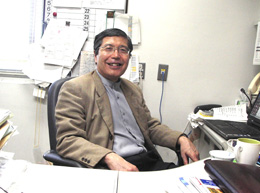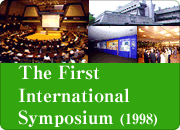Nagoya University
Toshihiko Osawa
Born in Himeji, Hyogo in 1946.
Acquired a PhD in Agriculture from the Faculty of Agriculture, The University of Tokyo.
Research Fellow, Earth Science, College of Science, The Australian National University
Recommended Researcher, Japan Society for the Promotion of Science
Visiting Professor, University of California
Professor, Graduate School of Bioagriculural Science, Nagoya University
Chairman, Sesame Science Society of Japan
Director, Antioxidant Unit
Standing Director, Japanese Society of Preventative Medicine

I was born in Himeji and, from when I was little, was basically raised on a farm that grew rice and crops because my father worked for an agricultural test site. I moved with my family from Himeji to Saijo, Hiroshima to Zentsuji, Kagawa as my father was transferred between test sites. Given the environment, I was pretty much destined to go into agriculture. Having been raised near to the Seto Inland Sea, I love the sea and went skindiving often as a kid. Because of my love for the sea, I went to Canberra, Australia to study after graduating from university. There, I switched the focus of my research from the chrysanthemums of my college days to eucalyptus (rooting of cut plants) and came across strong antibacterial substances in the plant. Owing to a background in organic chemistry, that was the starting point to my research into elucidating mechanisms for manifesting oxidation stress and defense mechanisms using anti-oxidant biofactors. Up until that point, I hadn't had much experience with the effects of nutritional components in other than your typical foods like sesame seeds and onions, but the development of advanced technologies such as micro array analysis made it possible to further identify components and internal mechanisms. Compared to wild species growing in Southeast Asia, Japanese rice contains less polyphenol and anthocyanin, but it must be extremely effective since rice is the main staple of the Japanese diet. Today, technologies are advancing for using biomarkers to identify pathogens in urine, blood and saliva. A number of ventures are trying to develop new health foods using biomarkers. There may even be talk of venture startups at this symposium. What interests me right now is perhaps research into life-prolonging treatments that offer hints on Alzheimer's, Parkinson's and other ailments that affect the brain. There will be a time that people will be able to prolong their lives by changing their eating habits. I look forward to this symposium as an opportunity to actively share information in applied fields with researchers from Japan and abroad.
| Hobbies: | Classical music, jazz (played trumpet in high school, etc.) |
|---|---|
| In Wakayama: | Speaking of Wakayama, I am involved in research aimed at developing highly functional biofactors from funadoko tangerines. I want to eat authentic sesame tofu from Mt. Koya and Wakayama's renown grouper. Also, since I love the ocean, I want to go to its full beauty. |





